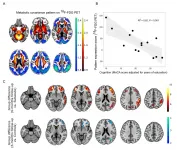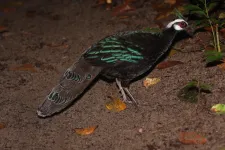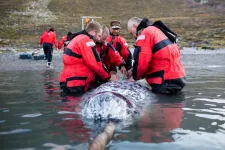(Press-News.org) Researchers at Karolinska Institutet in Sweden found industrial chemicals in the organs of fetuses conceived decades after many countries had banned the substances. In a study published in the journal Chemosphere, the researchers urge decision makers to consider the combined impact of the mix of chemicals that accumulate in people and nature.
"These are important findings that call for regulators to consider the collective impact of exposure to multiple chemicals rather than evaluating just one chemical at a time," says first author Richelle Duque Björvang, PhD student at the Department of Clinical Science, Intervention and Technology at Karolinska Institutet.
The researchers studied concentrations of 22 persistent organic pollutants (POPs). These are toxic chemicals that remain in the environment for long periods of time and accumulate in humans through food, drinking water and air particles. EU's members and many other countries have signed a treaty that prohibits or restricts manufacturing and use of these chemicals.
In the study, the researchers examined samples of fetal fat tissue, liver, heart, lung and brain from 20 pregnancies that for various reasons had ended in stillbirth in the third trimester in 2015-2016. The researchers identified at least 15 of the 22 POPs in every organ. Four chemicals were found in all tissues in all fetuses. The most pervasive chemicals were:
HCB, a pesticide previously used to protect food crops from fungi;
DDE, a metabolite of DDT, an insect killer used in the mid-1900s;
Variants of PCBs, chemicals formerly used in a range of electrical products.
Most current methods for estimating fetal exposure to chemicals rely on maternal blood and placenta samples as proxies. The new study found that, for some of the chemicals, the concentrations in the fetal tissues exceeded those found in the maternal blood and placenta. This can be explained by the fact that these chemicals tend to accumulate in fat tissue due to their structure. However, levels in fetal liver and lung also exceeded those found in the mother. Some pesticides - PeCB, α-HCH, γ-HCH and oxychlordane - were detected in fetal tissue even when they were not quantified in maternal blood samples or the placenta. According to the researchers, these latest findings suggest that blood and placenta samples may give a misleading picture on the diversity and concentration of chemicals that babies are exposed to during early development.
This study only investigated the presence and concentration of the various chemicals but not their links to potential health risks. However, the researchers point out that several previous studies have linked early life exposure to POPs to adverse health outcomes such as low birth weight, gestational diabetes, ADHD, infertility, obesity and reduced sperm production. For example, the European Food Safety Authority (EFSA) recently revised their risk assessment of dioxins and dioxin-like PCBs, and concluded that the dietary intake in Europe is currently at a level that can disrupt fertility in men.
"Getting an accurate picture of chemical exposure in early human development is critical to assessing both short and long-term health consequences for future generations," says last author Pauliina Damdimopoulou, researcher in the Department of Clinical Science, Intervention and Technology at Karolinska Institutet. "Therefore, we believe today's approaches estimating fetal chemical exposure, for example in birth cohort studies, need to be updated to better reflect the likelihood that for some chemicals, fetal exposure is actually greater than what the blood and placenta samples show."
Thirteen of the pregnancies also had data from an earlier study on PFAS (chemicals used in frying pans, food packaging and firefighting foam). By combining these data, the researchers were able to assess the proportion of chemicals in each type of tissue. While pesticides and PCBs were significantly overrepresented in fat tissue, more than half of the chemicals in the fetal lung, brain, liver and heart was due to PFAS. Overall, the highest concentration of a mix of chemicals were found in fat tissue and the lowest in the brain. The study found that the relative exposure of baby boys was higher compared to baby girls.
"Studies conducted in the 1960s and 1970s, when POPs were widely in use, found higher levels compared to ours," Richelle Duque Björvang says. "This shows that political action leading to restrictions in the use of chemicals has an impact on population exposures, although in the case of persistent chemicals it will take multiple generations to get rid of the exposure."
The researchers recognize that the study has some limitations, including a relatively modest sample size and that it only included fetuses who had died in the womb late in the pregnancy. Thus, it may not be fully representative of babies born alive.
INFORMATION:
The tissue samples were collected from the Stockholm Medical Biobank. The researchers have received funding from the Swedish Research Council for Sustainable Development (FORMAS), Jane & Aatos Erkko Foundation, and Women's Department in Sundsvall Development Fund.
Facts on POPs:
Persistent organic pollutants (POPs) are toxic human-made chemicals that once released into the environment remain intact for exceptionally long periods of times and become widely distributed through air, soil and water.
Currently, there are 30 POPs listed under the so-called Stockholm Convention on Persistent Organic Pollutants, an international environmental treaty initiated by the United Nations to eliminate or restrict the production and use of POPs. More than 150 countries have ratified the agreement.
The list includes pesticides, industrial chemicals and by-products, many of which were long banned by countries around the world but continue to affect the environment and animal and human health.
As consumers and corporations alike become more environmentally conscious, the chemical industry is working to find solutions to the plastic waste crisis. One idea is to use biodegradable polymers known as polyhydroxyalkanoates (PHA) as replacements for traditional plastic packaging and other materials. A feature article in Chemical & Engineering News, the weekly newsmagazine of the American Chemical Society, explores the possibilities and pitfalls of PHA.
PHA is not a new human invention; this class of polymers can be found in nature and is used to store cellular energy, writes Senior Editor Alex Tullo. Commercially, it is manufactured through the industrial fermentation of sugars or lipids. As cities ...
Researchers from the Singapore University of Technology and Design (SUTD) have demonstrated a technology that rapidly detects pollutants in water by measuring their impacts on swimming microorganisms.
Their proof-of-concept, published in Scientific Reports, does not require any chemicals, reagents or laboratory equipment. Instead, it leverages the regular camera of a smartphone as well as microorganisms called Paramecia that are ubiquitous in water bodies--making it especially suitable for assessing water drinkability in underdeveloped regions.
Typically, levels of environmental pollutants are measured by assessing their impact on a given population. Though such impacts may be visible after several days for microorganisms, it takes several years for the true scale to be ...
People with a rare autoimmune disease, who likely experience more serious isolation during a global pandemic, saw their anxiety and depression improve after receiving online mental health intervention through an international study involving investigators from Michigan Medicine.
The paper, END ...
Reston, VA--The effects of COVID-19 on the brain can be accurately measured with positron emission tomography (PET), according to research presented at the Society of Nuclear Medicine and Molecular Imaging (SNMMI) 2021 Annual Meeting. In the study, newly diagnosed COVID-19 patients, who required inpatient treatment and underwent PET brain scans, were found to have deficits in neuronal function and accompanying cognitive impairment, and in some, this impairment continued six months after their diagnosis. The detailed depiction of areas of cognitive impairment, neurological symptoms and comparison of impairment over a six-month time frame has been selected as SNMMI's 2021 Image of the Year.
Each year, SNMMI chooses an image that best exemplifies the most promising ...
LMU researchers have identified the 14-3-3sigma gene as an important suppressor of carcinogenesis in the gastrointestinal tract.
Intestinal cancers, also known as colorectal cancer, are among the most prevalent forms of malignancy worldwide. If detected early enough, tumors can be surgically excised. However, as cancer growth progresses, cells may escape from the primary tumor, which can then establish metastatic tumors in other organs. Once such satellite tumors have formed, survival rates fall significantly. Formation of the initial tumor can be triggered by mutations in any of a number of genes. Together with postdocs ...
CHAMPAIGN, Ill. -- Health care workers often don't adopt new guidelines for best practices in medical care until well after those guidelines are established. A team of researchers led by Eunice E. Santos, the dean of the School of Information Sciences at the University of Illinois Urbana-Champaign, has developed a new computational modeling and simulation framework to analyze decision-making and identify effective dissemination strategies for medical guidelines.
The research team examined guidelines for Type 2 diabetes that were established in 2012 and were still not adopted years later. The researchers found that health ...
The lush forests and more than 7,000 islands of the Philippines hold a rich diversity of life, with 258 bird species who live nowhere but the Philippine archipelago. A new study from University of Utah researchers suggests that, due to deforestation and habitat degradation, more bird species may be endangered that previously thought - including species that may not have been discovered yet. The study is published in Frontiers in Ecology and Evolution.
"Our study provides a roadmap for not only which species may warrant heightened conservation attention," says Kyle Kittelberger, a doctoral student in the University of Utah School of Biological Sciences, "but which traits ...
An algorithm can predict when narwhals hunt - a task once nearly impossible to gain insight into. Mathematicians and computer scientists at the University of Copenhagen, together with marine biologists in Greenland, have made progress in gathering knowledge about this enigmatic Arctic whale at a time when climate change is pressuring them.
The small whale, known for its distinctively spiraled tusk, is under mounting pressure due to warming waters and the subsequent increase in Arctic shipping traffic. To better care for narwhals, we need to learn more about their foraging behaviour - and how these may change as a result of human disturbances and global warming. Biologists know almost nothing about this. Because narwhals live in isolated Arctic regions and ...
For many of us, our smartphone has become our ever-present companion and is usually far more than just a phone. Thanks to the constant availability of online content as well as our reachability through messenger services and social networks via our smartphone, this everyday object's potential to distract us is high - at work too. This is why many employers view the use of smartphones during work time with suspicion, and countermeasures taken range from asking staff to refrain voluntarily from using them to banning smartphones in the workplace through an internal agreement. But do such measures actually work and, if so, how?
This is the ...
DURHAM, N.C. - Special diets, exercise programs, supplements and vitamins -- everywhere we look there is something supposed to help us live longer. Maybe those work: human average life expectancy has gone from a meager 40-ish years to a whopping 70-something since 1850. Does this mean we are slowing down death?
A new study comparing data from nine human populations and 30 populations of non-human primates says that we are probably not cheating the reaper. The researchers say the increase in human life expectancy is more likely the statistical outcome of improved survival for children and young adults, not slowing the aging clock.
"Populations get older mostly because more individuals get through those early stages of life," ...




